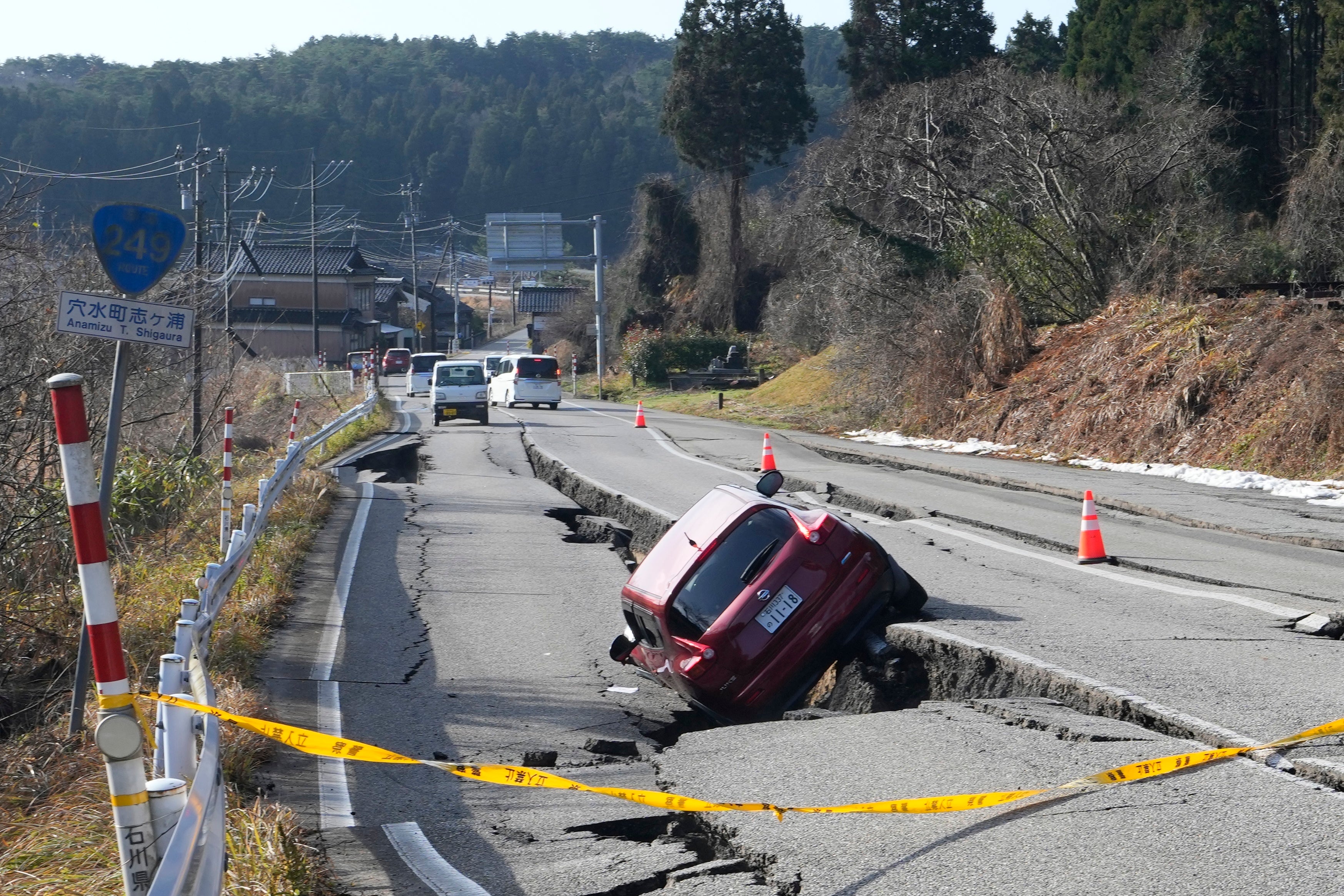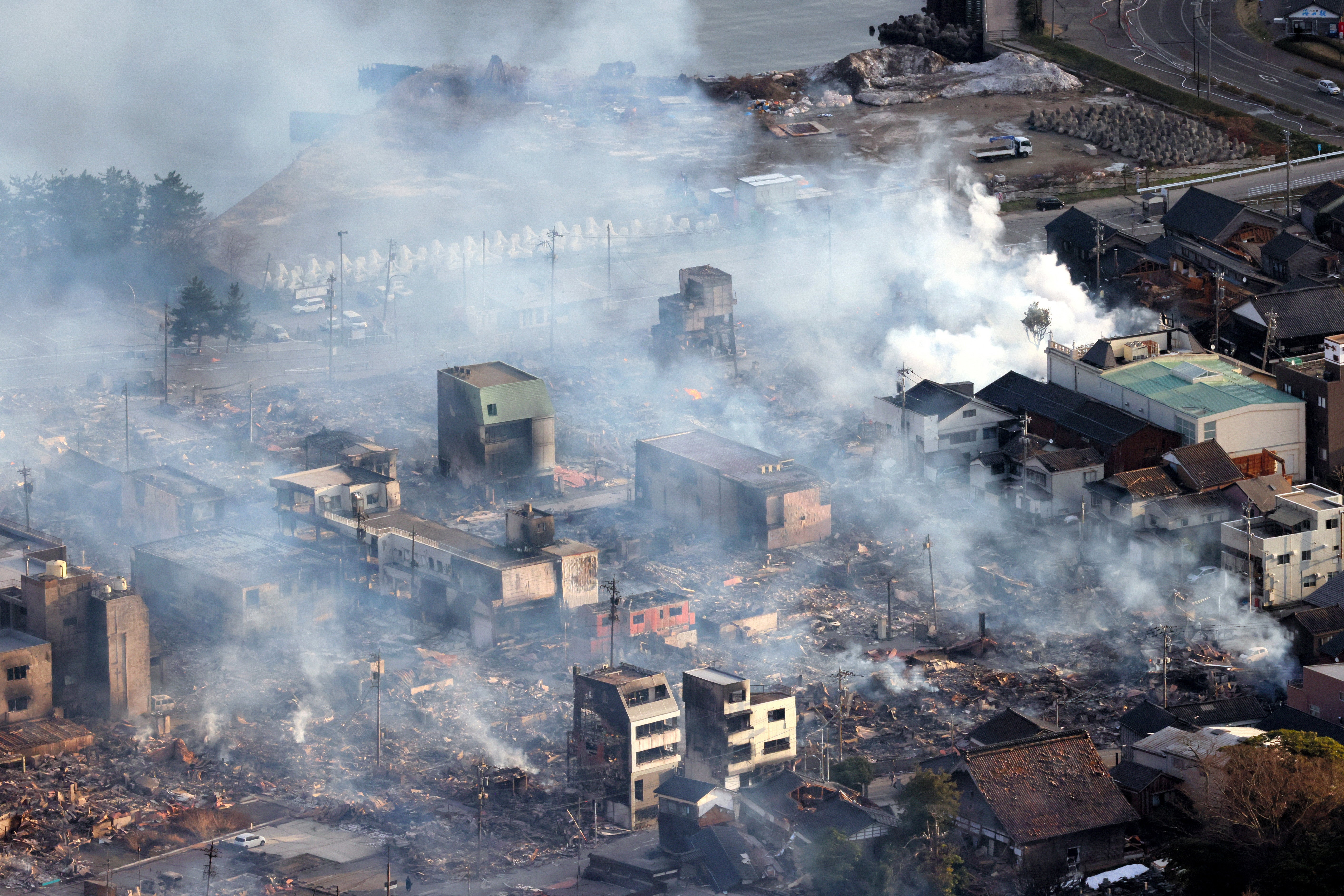Tsunami warnings force thousands to flee homes in Japan as powerful earthquakes kill 48
At least 48 people have died after the 7.6-magnitude earthquake brought down buildings in coastal towns
Your support helps us to tell the story
From reproductive rights to climate change to Big Tech, The Independent is on the ground when the story is developing. Whether it's investigating the financials of Elon Musk's pro-Trump PAC or producing our latest documentary, 'The A Word', which shines a light on the American women fighting for reproductive rights, we know how important it is to parse out the facts from the messaging.
At such a critical moment in US history, we need reporters on the ground. Your donation allows us to keep sending journalists to speak to both sides of the story.
The Independent is trusted by Americans across the entire political spectrum. And unlike many other quality news outlets, we choose not to lock Americans out of our reporting and analysis with paywalls. We believe quality journalism should be available to everyone, paid for by those who can afford it.
Your support makes all the difference.Tens of thousands of people were evacuated from their homes in Japan on Monday after a powerful earthquake triggered tsunami warnings and devastated towns on the country’s main island of Honshu.
The death toll has risen to 48 as rescuers faced what prime minister Fumio Kishida described as a “battle against time” to reach more trapped under collapsed buildings following the 7.6 magnitude quake, which sent one metre-high tsunami waves crashing onto the western coast on Monday shortly after 4pm local time [7am GMT].
More than 140 aftershocks continued to rock Japan as of Tuesday morning, according to the Japan Meteorological Agency, which warned that strong tremors could continue in the coming days.
Follow our live blog for the latest updates on the earthquake here.
Hundreds of buildings have collapsed in earthquake-hit areas, including in Niigata, Toyama, Fukui and Gifu prefectures, leaving many injured.
At its epicentre on the Noto peninsula, damage to roads has made relief and rescue work more difficult, while more than 30,000 households were left without power.
A major fire broke out in Wajima City, gutting more than 100 buildings.


Mr Kishida said he was personally leading the earthquake disaster response.
He described scenes of devastation on Noto peninsula, where rescuers were still finding it very difficult to reach the northern tip due to wrecked roads. Helicopter surveys had discovered many fires and widespread damage to buildings and infrastructure, he said.
“It is necessary to rescue victims of collapsed buildings as soon as possible, and I have given instructions to use all means possible to reach the site as soon as possible,” Mr Kishida said.
The earthquake brought public transport to a standstill with passengers stranded after train, air and metro services were suspended.
More than 1,400 passengers aboard four trains between Toyama and Kanazawa stations were stranded after their journey was suspended for almost 11 hours.

Kyodo News reported four deaths in Ishikawa, citing the Prefectural Crisis Management Team, four people have been confirmed dead, including a man and woman in their 50s, a young boy, and a man in his 70s.
Eight people were confirmed dead in the city of Wajima alone and at least seven were injured.
The Asahi newspaper cited police as saying a man in his 90s had been pulled from the wreckage of a building and taken to hospital but was confirmed dead.
By Tuesday, all tsunami advisories along the Sea of Japan have been lifted.
The powerful quake, followed by several tremors, led authorities to issue a tsunami warning, meaning three metre-high waves could occur – although this was later downgraded to an advisory, which forecast waves with a height of one metre.
Police and local authorities early on Tuesday reported cases of bodies being pulled from the rubble of collapsed buildings. The full extent of the damage, and the death toll, is unlikely to be clear until later on Tuesday.


A total of 51,000 people living in coastal areas in the coastal regions of Ishikawa, Niigata and Toyama prefectures were evacuated to higher ground and told to stay away with initial fears of waves up to five metres.
They were given shelter in government offices and stadiums as temperatures plummeted to below freezing outside.
The earthquake that struck on New Year’s Day was felt by residents across Tokyo and in the Kanto area.
Neighbouring South Korea, North Korea and Russia also issued tsunami warnings for their Sea of Japan coasts, with South Korean authorities ordering people in some regions to evacuate to higher ground.
Images on social media showed panicked people hiding under rocking tables as the earthquake hit and some visuals showed damaged houses in the aftermath of the tremor.


Japanese media showed a gathering of individuals, among them a woman with a baby on her back, standing beside extensive cracks that had torn through the pavement.
Flights to the region were cancelled by Nippon Airways and Japan Airlines and 40 train lines were suspended.
During a nationally broadcast news conference, the Japanese Meteorological Agency warned that the region might experience additional significant earthquakes in the coming week, with heightened risk particularly in the next two or three days.
It said Monday’s major tsunami warning for Ishikawa was the first time this level of alert had been issued since March 2011, when a massive earthquake measuring over 9 on the richter scale devastated towns and triggered meltdowns in Fukushima nuclear power plant.
Mr Kishida’s office urged authorities to “take thorough measures to prevent damage, such as the evacuation of residents” and prioritise human life above all else.
Government spokesperson Hayashi Yoshimasa said in an emergency press conference that authorities were still checking the extent of the damage and warned residents to prepare for possible further quakes.
Expressing the need for urgency with regards to evacuations, Mr Yoshimasa said: “Every minute counts. Please evacuate to a safe area immediately.”
Japan is an extremely quake-prone nation. There are hundreds of earthquakes in the country every year although most cause little or no damage.

Join our commenting forum
Join thought-provoking conversations, follow other Independent readers and see their replies
Comments